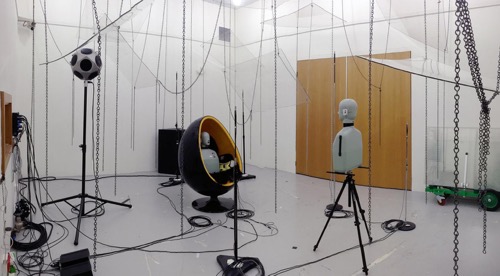If you've ever been distracted by noisy people while attempting to concentrate on work within an open-plan office, 'local acoustic treatment' based on principles of listening to your own voice may be able to provide relief in the future.
ACOUSTICAL SOCIETY OF AMERICA - WASHINGTON, D.C. -- Overhearing conversations from nearby workstations can be one of the most distracting aspects of working in an open-plan office. To make these environments less noisy, while still providing acoustic support for speaking and listening, researchers are creating small "acoustic islands" using high-back chairs and retroreflective ceilings to direct sound to help you hear your own conversations -- not others' -- better.

To make open offices less noisy, researchers are creating small "acoustic islands" using high-back chairs and retroreflective ceilings to direct sound to help you hear your own conversations -- not others' -- better. During the 175th ASA Meeting, Manuj Yadav will present work toward solutions to the speech distraction problem in open-plan offices. Chairs and pods may not only shield you from noise, but also enable more comfortable conversations over short distances. Photo courtesy of Densil Cabrera.
An international standard, ISO 3382-3, specifies measurements of the acoustical properties of a room and it focuses on large-scale acoustic measurements and solutions. These solutions aren't always effective for the short conversational distances in open-plan offices, according to researchers in Australia, who've discovered that open-plan spaces could benefit from additional specialized and local acoustic treatments.
During the 175th Meeting of the Acoustical Society of America, held May 7-11, 2018, in Minneapolis, Minnesota, Manuj Yadav, a postdoctoral research associate at the University of Sydney, presented his and his colleagues' work toward solutions to the speech distraction problem in open-plan offices.
"The local acoustic treatment we've studied so far includes the use of high-back chairs -- with or without sound absorption near the head -- and 'retroreflective ceilings' that reflect sound back in the direction of the source, which allows you to hear your own voice reflected back to your ears much louder than is possible with flat or other types of hard ceiling surfaces or absorptive ceilings," Yadav said.
People tend to "simply put, lower their voices when they receive some support in the form of reflections from the room and nearby surfaces," Yadav said. "The opposite situation is true in a conversational context, in which people tend to raise their voices if they don't think their voice is audible to the person they're talking to. A somewhat extreme example is everyone progressively raising their voices within a large gathering to talk to someone at less than an arm's length, since they can't hear others or themselves -- the cocktail party effect."
Retroreflective surfaces aren't commonly used in acoustics today, so their use as a ceiling treatment in offices is a novel application. "We hope that our work encourages more researchers to explore the use of retroreflectors, which are likely to be useful in cases in which support for listening to your own voice is needed in the form of strong reflections from nearby surfaces," Yadav said.
The researchers' work with high-back chairs is also one of the first efforts to quantify the acoustic effect of chairs or furniture ensembles. "This may encourage some manufacturers of these products, which are becoming quite popular, to actually measure their acoustic effects," Yadav said. "Unfortunately, today these products are just labeled 'acoustic' for marketing purposes -- without any data or justification."
So far, Yadav and colleagues have found that their local acoustic treatment "can, in many cases, provide substantial enhancement for speech communication at short distances and reduce the disturbance due to ambient noise when you're trying to concentrate," he said. "This work, however, centers mostly on laboratory-based studies and much more needs to be done in terms of testing with actual people in different communication scenarios, but the effects are there for anyone to hear."
###
Presentation 1pAA3 "The irrelevant speech effect in multi-talker environments: Applications to open-plan offices," by Manuj Yadav, The 175th Meeting of the Acoustical Society of America, Minneapolis, Minnesota.
BOUT THE ACOUSTICAL SOCIETY OF AMERICA
The Acoustical Society of America (ASA) is the premier international scientific society in acoustics devoted to the science and technology of sound. Its 7,000 members worldwide represent a broad spectrum of the study of acoustics. ASA publications include The Journal of the Acoustical Society of America (the world's leading journal on acoustics), Acoustics Today magazine, books, and standards on acoustics. The society also holds two major scientific meetings each year. For more information about ASA, visit our website at https://www.
Source: https://www.eurekalert.org/pub_releases/2018-05/asoa-ca050118.php

